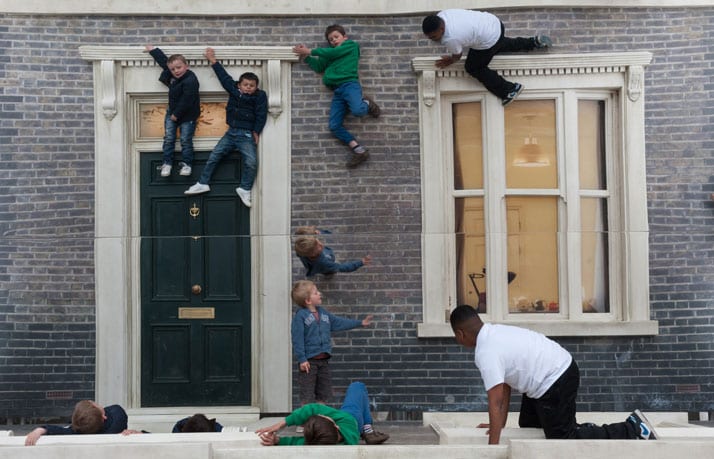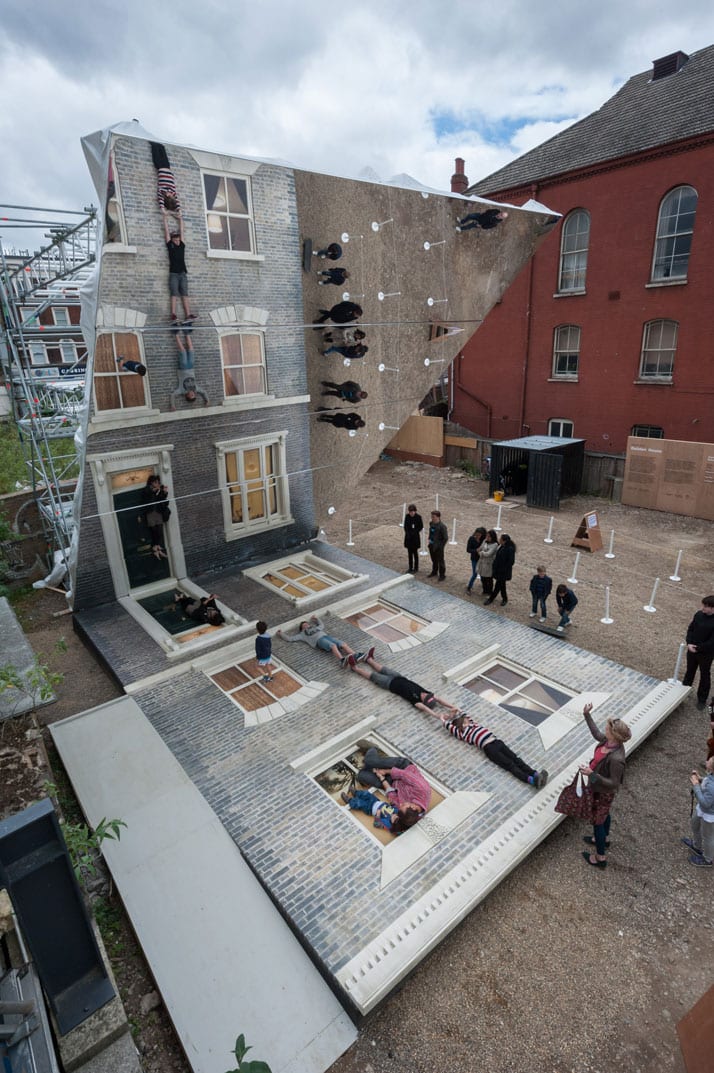Something unusual is taking place in the streets of east London. People are defying the laws of gravity, literally walking across the facade of a rather curious Victorian building. Comfortably folded in the crevice of white framed windows, adults read leisurely while young children hang single handedly from the frame of the front door. Ordinary people are sticking to this building as if they were Spider Man. Argentine artist and master illusionist Leandro Erlich is the mind behind Dalston House, an off-site installation that is changing the way Londoners engage with their neighborhood.
Barbican Art Gallery launched Beyond Barbican a summer cultural program that features pop- up commissions and collaborations on the streets of London in an effort to engage with the public beyond the gallery walls in Hackney. Barbican commissioned critically acclaimed artist Leandro Erlich to create Dalston House, which has already been visited by over 18,000 people in its first two weeks after opening on June 26. Playful and participatory in nature, the installation is composed of two elements- first a facade of a late nineteenth century Victorian terraced house that lies flat on the ground and measures approximately 33 by 23 feet. A mirror positioned at a 45-degree angle creates the illusion that people sitting on top of the facade are hanging from its exterior. For Erlich, mirrors play an integral role in his artistic practice and methodology as they are a quotidian and familiar object, that is capable of reflecting what is placed in front of them while revealing new ways of seeing. Assistant curator Alano Pardo explains that the project also inspires reflection and “fosters a dialogue about the built environment and the process of regeneration and gentrification in Dalston, which has undergone dramatic changes over the last decade.” The neighborhood surrounding Dalston House has remained mostly vacant since it was bombed in World War II.

Leandro Erlich: Dalston House
Installation images
© Gar Powell-Evans 2013
Courtesy of Barbican Art Gallery
Erlich is no stranger to the international stage having created similar installations of Bâtiment first produced in Paris in 2004 and then in Japan and Buenos Aires. While the construction remains consistent, the full impact is achieved by creating architectural forms that are native to the area surrounding the installation. Dalston House is the first time that Erlich’s installation has appeared on the streets, outside of an arts centre or biennial. Erlich explained to Installation that is through architecture that his installations truly become alive. “Architecture is the universe I like to explore,” he says and it is through this lens that “ordinary spaces are questioned and discovered.”

Leandro Erlich: Dalston House
Installation images
© Gar Powell-Evans 2013
Courtesy of Barbican Art Gallery
Installation spoke further with with Alona Pardo to better understand the construction of the installation. The facade is rather similar to a theatre set made largely of waterproof plywood sheet with a printed vinyl canvas to create the brickwork. The window frames and moldings are made of fiberglass and a scenic artist distressed them to make them appear aged. The front door is actual hardwood Victorian door that has been recycled. The window panes are made of acrylic with photographic prints adhered. to the back. The mirror responsible for facilitating the spectacular illusion is not a standard mirror as it would not withstand the load bearing capacity of the rigging scaffold that keeps the mirror in place at 45 degrees. The mirror is foil is stretched across a lightweight, aluminum frame. Once stretched the mirror film assumes the same properties as a real mirror.
Located at 1-7 Ashwin Street the installation will remain open and free to the public through August 4. What better time to plan a trip across the pond and be a part of a truly off the wall installation?

Installation images
© Gar Powell-Evans 2013
Courtesy of Barbican Art Gallery
All images ©Barbican Art Gallery

Amazing what a mirror tilted at a 45-degree angle can do. Inspires a new way of seeing!
Have you seen those paintings on the ground that look 3D when you take a picture of yourself on it at the right angle? This is so much cooler!